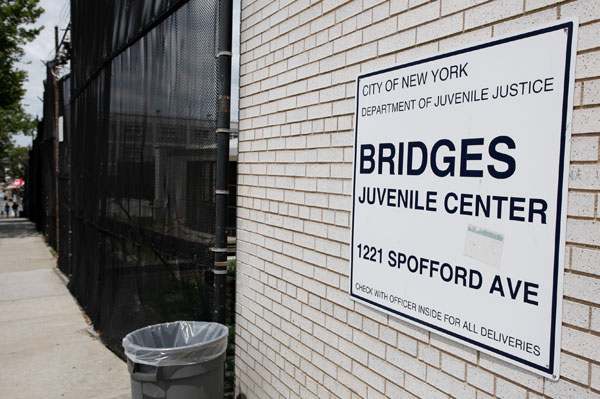
Photo by: Marc Fader
The Bridges youth detention facility in the Bronx. Long a target of community opposition, it is due to close in April. But it’s unclear how a City Hall proposal to take over part of the state’s juvenile justice system will affect detainees in city-based youth facilities.
Four blocks from the East River and a stone’s throw from the Bruckner Expressway is New York City’s Bridges Detention Center, where city youth who’ve entered the juvenile justice system are held prior to hearings and adjudications.
But almost no one calls it Bridges. They call it Spofford.
Officially, Spofford was closed in 1989. But its notoriety as a site for escapes, abuse and community opposition lives on. The city has long promised to close Bridges/Spofford. But a Brooklyn facility slated to receive Bridges’ population has a persistent problem with mold. Until the mold is eradicated and the facility renovated, youth will continue to be held at Bridges.
Bridges is part of a youth detention network over which Mayor Michael Bloomberg is seeking more control. A month ago, the mayor challenged incoming Gov. Andrew Cuomo and the state legislature to give the city control over facilities that are used to house New York City children in the juvenile justice system.
With empty beds at more than half of the state’s facilities, and labor laws that require year-long notification prior to closing those detention centers, the mayor asserts that millions could be saved if the city took over from the state. The mayor also argues that the city can develop alternatives to detention and that city youth and their families fare better when kids are placed close to home.
The mayor’s proposal, the subject of a City Council hearing today, might solve some of the problems the state system faces. But it raises a new set of questions. Moneys saved by the city takeover would not be reinvested in youth services or juvenile justice. Decisions that affect the city’s neediest youth and most fragile families are slated to be made without community input and participation.
The mayor’s proposal also raises questions about the detention facilities currently sited in New York City, but run by the state, like Bridges. All of those facilities are well under capacity. As of December 13, a group home for young mothers in Staten Island had one resident. Other sites in Staten Island and Queens are less than half full. And one facility in Brooklyn, designed to serve 25 young people, houses a single girl.
A system and its changes
Young people detained in the juvenile justice system are charged with offenses that can range from truancy to assault, robbery and gang violence. Children as young as seven can be detained, but most are young teens, and half are 15 years old—after which, in New York (alone, but for North Carolina, among the 50 states) a youth can be charged as an adult.
On average, youth in detention remain there for about 28 days, until their case can be heard and a disposition made: return to the community, with or without prescribed support services, or remand to a state or private facility.
Last January, a merger of the city’s juvenile justice department, which operates state detention facilities in the five boroughs, and the Administration for Children’s Services was announced, designed to improve outcomes, streamline communication and better support the hundreds of children who are part of both realms: Up to two-thirds of youth detained in the juvenile justice system have had prior contact with ACS.
Since 2005, the average daily number of youth in state facilities has dropped significantly, from a high of 870 to 534, in 2009, consistent with general downward trends in crime, adult and youth, in New York City.
The racial disparities that pervade New York’s correctional facilities, adult and juvenile sites inclusive, persist: Executive Deputy Commissioner for the Division of Youth and Family Justice at NYC’s Administration for Children’s Services, has called the overrepresentation of children of color an issue of national concern. “In New York City, black children are almost 48 times more likely than white children to be placed in a state facility,” Busching testified before the City Council in October.
And despite the lower headcount, the system’s costs continue to mount. The city, which splits the cost for city youth in state facilities 50-50 with the state, paid nearly $62 million in 2010—more than it paid in 2000, when more kids were incarcerated or in detention.
Indeed, even when state facility populations contract, state fees persist, because rates are based on prior occupancy statistics. Caring for children in detention, no matter the security level, costs a great deal of money: A year in a secure facility costs, on average, $228,000 per child; the cost rises in limited-secure facilities ($272,000) and in group homes ($346,000). Compare that to family foster care ($123,000) and evening-reporting centers ($112,000), where youth live with their families or in foster care but are obliged to check in nightly.








